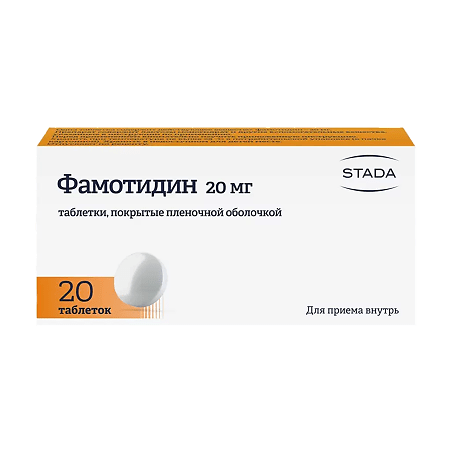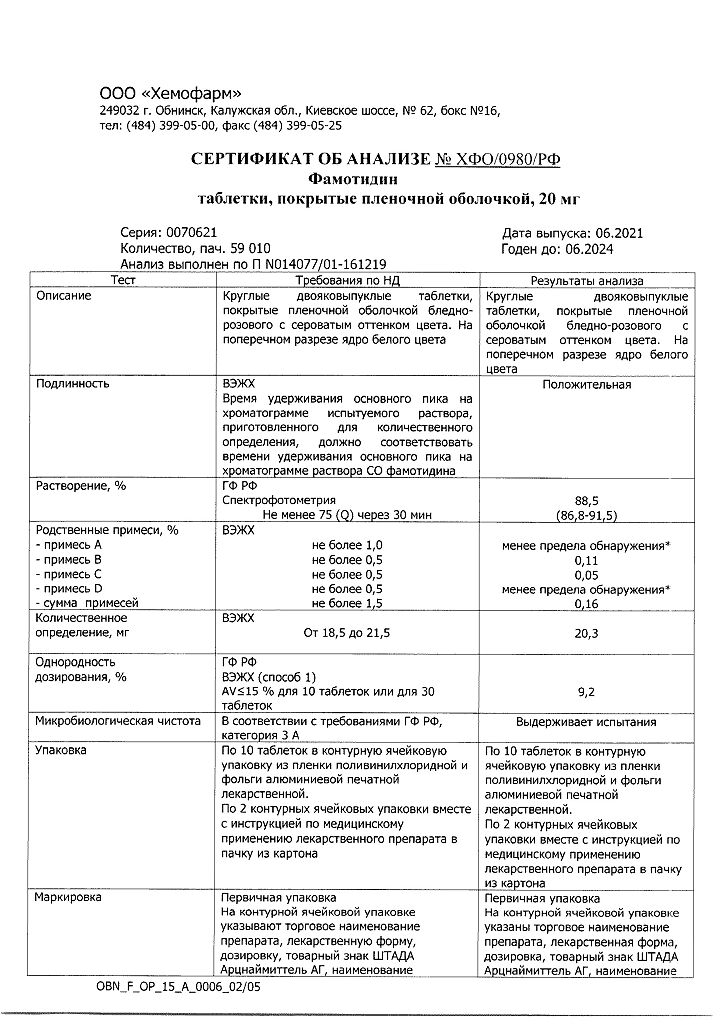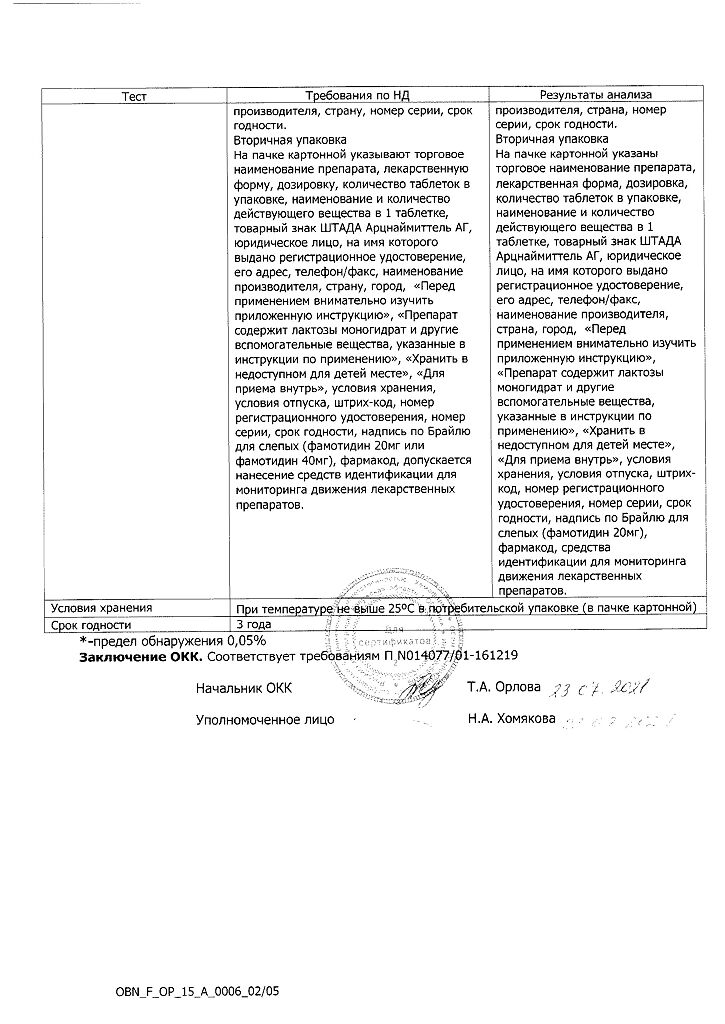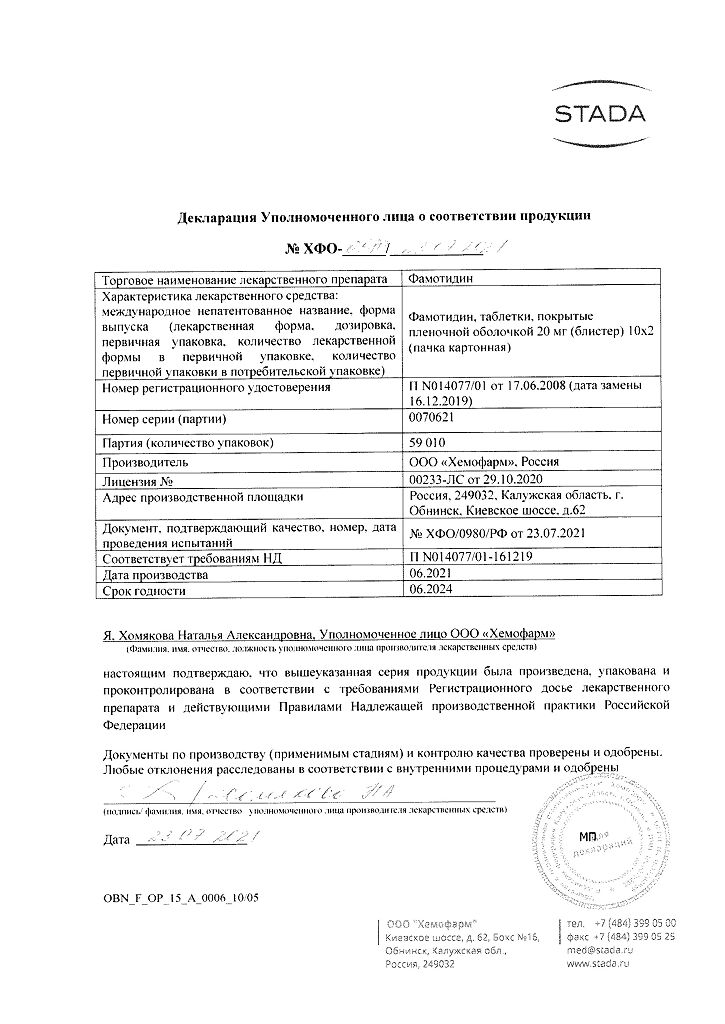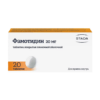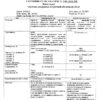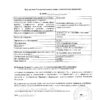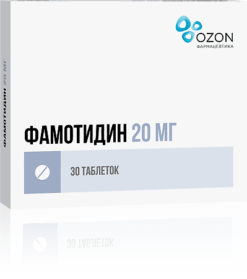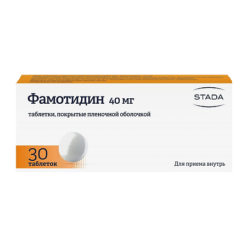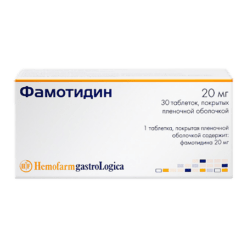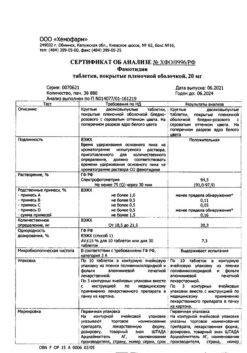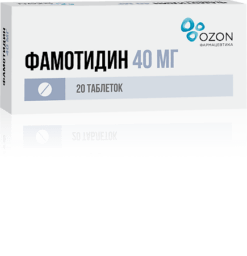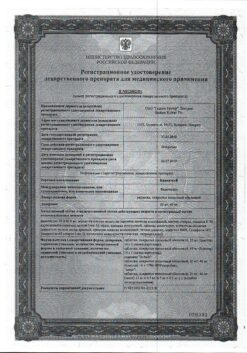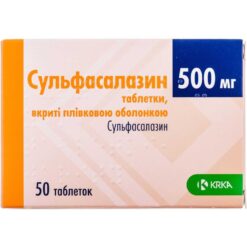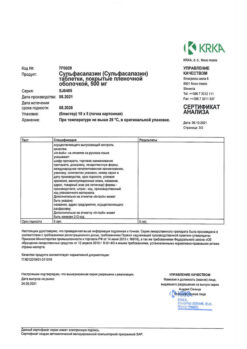No products in the cart.
Famotidine, 20 mg 20 pcs
€1.44 €1.31
EAN: 4607143560420
SKU: 204741
Categories: Medicine, Stomach, intestines, liver, Ulcer and gastritis
Description
Famotidine is an anti-ulcer.
Blocks histamine H2 receptors, inhibits the production of hydrochloric acid.
Indications
Indications
Active ingredient
Active ingredient
Composition
Composition
1 film-coated tablet contains the active ingredient famotidine 20 mg.
Excipients:
Corn starch – 16.0 mg,
Microcrystalline cellulose – 78.35 mg,
Silicon dioxide – 1.4 mg,
Talc – 5.625 mg,
Magnesium stearate – 1.125 mg,
Croscarmellose sodium – 2.5 mg.
The shell:
Hypromellose – 2.5 mg,
Titanium dioxide – 1.53 mg,
Lactose monohydrate – 1.313 mg,
Macrogol-4000 – 0.5 mg,
Triacetin – 0.375 mg,
Iron oxide yellow dye [E172] – 0.021 mg,
Iron oxide red dye [E172] – 0.006 mg,
Iron oxide black dye [E172] – 0.005 mg.
How to take, the dosage
How to take, the dosage
In the mouth, without chewing, with plenty of water.
Adults:
In gastric and 12 duodenal ulcer in the acute phase, symptomatic ulcers, erosive gastroduodenitis usually prescribe 20 mg 2 times a day or 40 mg once a day at bedtime.
If necessary, the daily dose can be increased to 80 – 160 mg. The course of treatment is 4-8 weeks.
In case of dyspepsia associated with increased secretory function of the stomach, prescribe 20 mg 1 to 2 times a day.
In order to prevent recurrence of peptic ulcer disease, it is prescribed 20 mg once a day before bedtime.
In reflux esophagitis 20-40 mg twice a day for 6-12 weeks.
In Zollinger-Ellison syndrome the dose of the drug and the duration of treatment are determined individually.
The starting dose is usually 20 mg every 6 hours and may be increased to 160 mg every 6 hours.
To prevent aspiration of gastric juice during general anesthesia, 40 mg is prescribed in the evening and/or in the morning before surgery.
The tablets of Famotidine should be swallowed without chewing, with plenty of water.
In case of renal impairment, if creatinine clearance is less than 30 ml/min or serum creatinine more than 3 mg/100 ml, the daily dose of the drug should be reduced to 20 mg.
Interaction
Interaction
Antacids interfere with absorption (a break of at least 1-2 hours between intake of antacids and famotidine is recommended).
Special Instructions
Special Instructions
Before starting treatment, the possibility of malignant disease of the esophagus, stomach or duodenum should be excluded, because Famotidine may mask the symptoms.
The symptoms of duodenal ulcer disease may disappear within 1-2 weeks, therapy should be continued until scarring is confirmed by endoscopic or X-ray examination.
Pharmotidine should be withdrawn gradually because of the risk of ricochet syndrome if abruptly withdrawn.
In long-term treatment in weakened patients, as well as in case of stress, bacterial damage of the stomach with subsequent spread of infection is possible.
Famotidine (H2-histamine receptor blocker) should be taken 2 hours after taking itraconazole or ketoconazole to avoid significant reduction of their absorption.
It counteracts the effects of pentagastrin and histamine on the acid-forming function of the stomach, so it is not recommended to use Famotidine in the 24 hours prior to the test.
Famotidine suppresses the skin reaction to histamine, thus leading to false-negative results (before diagnostic skin tests to detect an immediate allergic skin reaction, it is recommended to stop using Famotidine).
At the time of treatment, consumption of food, beverages, etc. should be avoided. During treatment, avoid eating foods, drinks, etc. which may irritate the gastric mucosa.
The effectiveness of Famotidine in inhibiting nocturnal gastric acid secretion may be reduced by smoking.
Patients with burns may need to increase the dose of the drug due to increased clearance.
If a dose is missed, it should be taken as soon as possible; do not take if it is time for the next dose; do not double the dose. If there is no improvement, consultation with a physician is necessary.
Synopsis
Synopsis
Contraindications
Contraindications
With caution: hepatic and/or renal insufficiency, cirrhosis with portosystemic encephalopathy (in anamnesis), immunodeficiency, childhood age.
Side effects
Side effects
The digestive system: dry mouth, nausea, vomiting, abdominal pain, rarely – loss of appetite, increased activity of “liver” transaminases, constipation, diarrhea, jaundice, hepatocellular, cholestatic or mixed hepatitis, in some cases may develop acute pancreatitis.
Nervous system disorders: headache, dizziness; asthenia, drowsiness, insomnia, anxiety, nervousness, depression, psychosis; there have been described cases of hallucinations, confusion, blurred vision, hyperthermia.
Cardiovascular system disorders: very rarely – decreased blood pressure, bradycardia, atrioventricular block, arrhythmia, vasculitis.
Allergic reactions: skin rash, itching, bronchospasm, angioedema, erythema multiforme, exfoliative dermatitis, Stevens-Johnson syndrome, toxic epidermal necrolysis, anaphylactic shock.
Hematopoietic organs: rarely – neutropenia, leukopenia, thrombocytopenia, hemolytic anemia; in single cases – agranulocytosis, pancytopenia, bone marrow aplasia.
With the reproductive system: in prolonged use of high doses – hyperprolactinemia, gynecomastia, amenorrhea, decreased libido, impotence.
Others: rarely fever, arthralgia, myalgia, tinnitus, dry skin, alopecia.
Overdose
Overdose
Symptoms:
Vomiting, motor agitation, tremor, decreased blood pressure, tachycardia, collapse.
Treatment:
Gastric lavage, symptomatic and supportive therapy, hemodialysis.
Pregnancy use
Pregnancy use
It penetrates through the placenta. Use during pregnancy is possible only if the benefit to the mother exceeds the risk to the fetus.
It penetrates into breast milk; if it is necessary to use during lactation, either discontinue the drug or breastfeed.
Similarities
Similarities
Additional information
| Weight | 0.011 kg |
|---|---|
| Shelf life | 3 years. Do not use after the expiration date stated on the package. |
| Conditions of storage | In a place protected from light and moisture, at 15-25 °C |
| Manufacturer | Chemopharm LLC, Russia |
| Medication form | pills |
| Brand | Chemopharm LLC |
Other forms…
Related products
Buy Famotidine, 20 mg 20 pcs with delivery to USA, UK, Europe and over 120 other countries.

